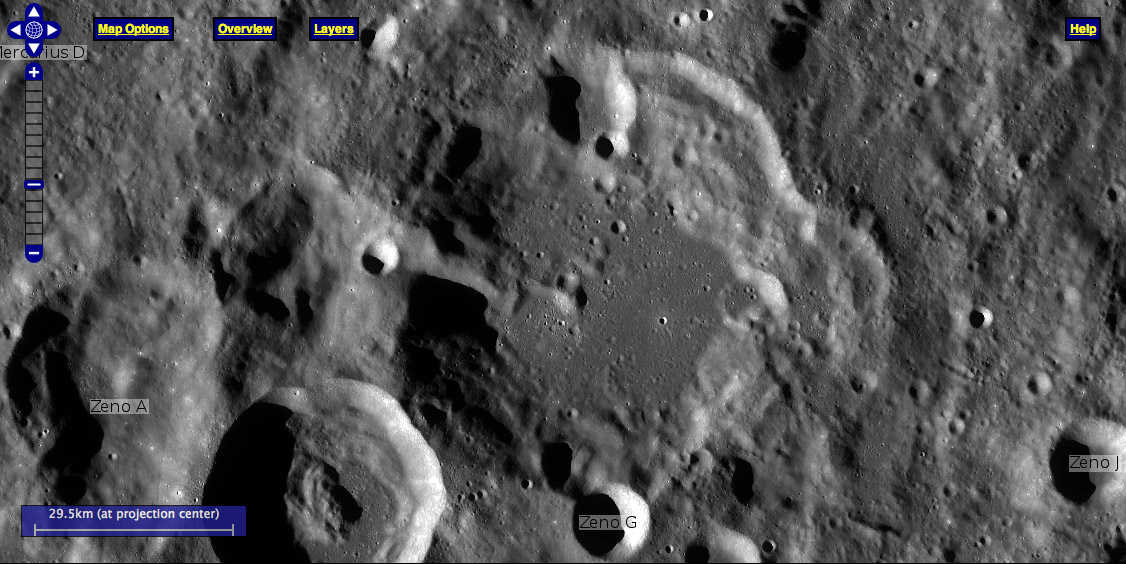Difference between revisions of "June 6, 2013"
| Line 3: | Line 3: | ||
<!-- ws:start:WikiTextHeadingRule:0:<h1> --> | <!-- ws:start:WikiTextHeadingRule:0:<h1> --> | ||
<!-- ws:start:WikiTextLocalImageRule:6:<img src="/file/view/LPOD-jun6-13.jpg/436620448/LPOD-jun6-13.jpg" alt="" title="" /> -->[[File:LPOD-jun6-13.jpg|LPOD-jun6-13.jpg]]<!-- ws:end:WikiTextLocalImageRule:6 --><br /> | <!-- ws:start:WikiTextLocalImageRule:6:<img src="/file/view/LPOD-jun6-13.jpg/436620448/LPOD-jun6-13.jpg" alt="" title="" /> -->[[File:LPOD-jun6-13.jpg|LPOD-jun6-13.jpg]]<!-- ws:end:WikiTextLocalImageRule:6 --><br /> | ||
| − | <em>image from [http://webmap.lroc.asu.edu/lunaserv.html | + | <em>image from [http://webmap.lroc.asu.edu/lunaserv.html LRO Lunaserv] (NASA/GSFC/Arizona State University)</em><br /> |
<br /> | <br /> | ||
Zeno is a crater that no one has paid much attention to. It isn't big, dramatic or fresh, and it isn't so odd that it demands an explanation.<br /> | Zeno is a crater that no one has paid much attention to. It isn't big, dramatic or fresh, and it isn't so odd that it demands an explanation.<br /> | ||
| Line 11: | Line 11: | ||
we did in the unpublished [http://the-moon.wikispaces.com/Lunar+%26+Planetary+Laboratory+Catalog+of+Lunar+Craters LPL Catalog of Lunar Craters]. [http://the-moon.wikispaces.com/Sekiguchi%2C+1972 Sekiguchi] measured a height for the central peak of 160 m, but that was back<br /> | we did in the unpublished [http://the-moon.wikispaces.com/Lunar+%26+Planetary+Laboratory+Catalog+of+Lunar+Craters LPL Catalog of Lunar Craters]. [http://the-moon.wikispaces.com/Sekiguchi%2C+1972 Sekiguchi] measured a height for the central peak of 160 m, but that was back<br /> | ||
in 1972 making shadow-length measures on printed copies of the Kuiper <em>Photographic Lunar Atlas.</em> My Quickmap measure suggest that<br /> | in 1972 making shadow-length measures on printed copies of the Kuiper <em>Photographic Lunar Atlas.</em> My Quickmap measure suggest that<br /> | ||
| − | 425-450 m is closer to the correct height. Back in 1978 the USGS North Polar [http://www.lpi.usra.edu/resources/mapcatalog/usgs/I1062/150dpi.jpg | + | 425-450 m is closer to the correct height. Back in 1978 the USGS North Polar [http://www.lpi.usra.edu/resources/mapcatalog/usgs/I1062/150dpi.jpg Geologic Map] considered Zeno to be Nectarian in age,<br /> |
older than the Imbrium Basin. That is consistent with its battered look, but the odd deformation of its western wall is of uncertain origin;<br /> | older than the Imbrium Basin. That is consistent with its battered look, but the odd deformation of its western wall is of uncertain origin;<br /> | ||
perhaps a crater formed on the wall, with the ridge extending to the floor a remnant. Despite modern information, Zeno is destined to<br /> | perhaps a crater formed on the wall, with the ridge extending to the floor a remnant. Despite modern information, Zeno is destined to<br /> | ||
remain, especially from a telescopic vantage point, of minor interest.<br /> | remain, especially from a telescopic vantage point, of minor interest.<br /> | ||
<br /> | <br /> | ||
| − | <em>[mailto:tychocrater@yahoo.com | + | <em>[mailto:tychocrater@yahoo.com Chuck Wood]</em><br /> |
<br /> | <br /> | ||
<strong>Related Links</strong><br /> | <strong>Related Links</strong><br /> | ||
Revision as of 18:05, 11 January 2015
Craters Beginning with Z

image from LRO Lunaserv (NASA/GSFC/Arizona State University)
Zeno is a crater that no one has paid much attention to. It isn't big, dramatic or fresh, and it isn't so odd that it demands an explanation.
But it is a named crater about 65 km wide, and the paucity of information in the Moon-Wiki suggests that a gentle update would not be
remiss. The Moon-Wiki list two prior depths, 2.59 and 4.42 km; measurement with the LRO QuickMap altimetry tool gives a maximum
depth of 4.75 km, but 3 km is more typical. Often, the deepest depth - the longest shadow - is what is reported - certaintly that is what
we did in the unpublished LPL Catalog of Lunar Craters. Sekiguchi measured a height for the central peak of 160 m, but that was back
in 1972 making shadow-length measures on printed copies of the Kuiper Photographic Lunar Atlas. My Quickmap measure suggest that
425-450 m is closer to the correct height. Back in 1978 the USGS North Polar Geologic Map considered Zeno to be Nectarian in age,
older than the Imbrium Basin. That is consistent with its battered look, but the odd deformation of its western wall is of uncertain origin;
perhaps a crater formed on the wall, with the ridge extending to the floor a remnant. Despite modern information, Zeno is destined to
remain, especially from a telescopic vantage point, of minor interest.
Chuck Wood
Related Links
Rükl plate 16
21st Century Atlas chart L1 (unlabelled).



